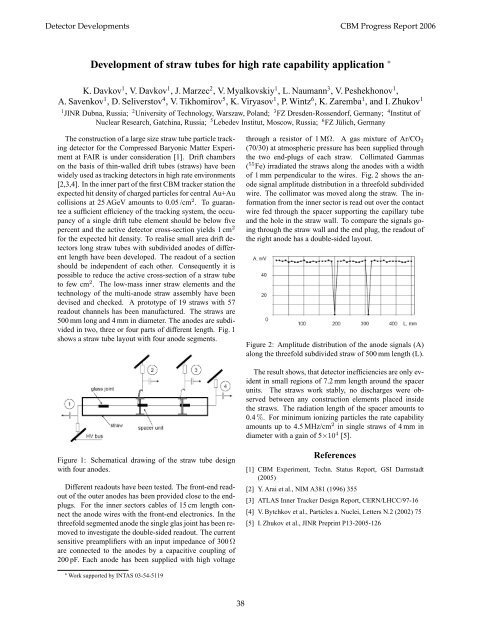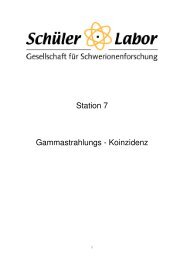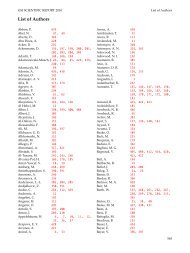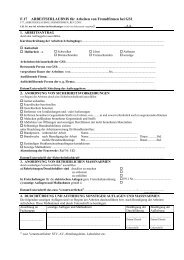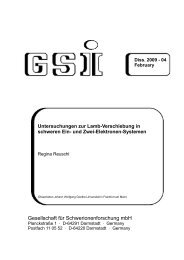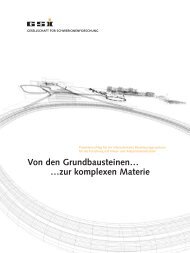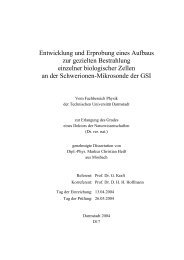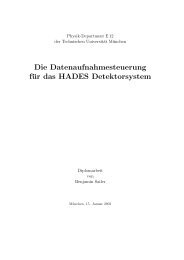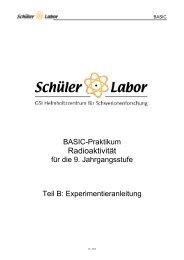CBM Progress Report 2006 - GSI
CBM Progress Report 2006 - GSI
CBM Progress Report 2006 - GSI
You also want an ePaper? Increase the reach of your titles
YUMPU automatically turns print PDFs into web optimized ePapers that Google loves.
Detector Developments <strong>CBM</strong> <strong>Progress</strong> <strong>Report</strong> <strong>2006</strong><br />
Development of straw tubes for high rate capability application ∗<br />
K. Davkov 1 , V. Davkov 1 , J. Marzec 2 , V. Myalkovskiy 1 , L. Naumann 3 , V. Peshekhonov 1 ,<br />
A. Savenkov 1 , D. Seliverstov 4 , V. Tikhomirov 5 , K. Viryasov 1 , P. Wintz 6 , K. Zaremba 1 , and I. Zhukov 1<br />
1 JINR Dubna, Russia; 2 University of Technology, Warszaw, Poland; 3 FZ Dresden-Rossendorf, Germany; 4 Institut of<br />
Nuclear Research, Gatchina, Russia; 5 Lebedev Institut, Moscow, Russia; 6 FZ Jülich, Germany<br />
The construction of a large size straw tube particle tracking<br />
detector for the Compressed Baryonic Matter Experiment<br />
at FAIR is under consideration [1]. Drift chambers<br />
on the basis of thin-walled drift tubes (straws) have been<br />
widely used as tracking detectors in high rate environments<br />
[2,3,4]. In the inner part of the first <strong>CBM</strong> tracker station the<br />
expected hit density of charged particles for central Au+Au<br />
collisions at 25 AGeV amounts to 0.05 /cm 2 . To guarantee<br />
a sufficient efficiency of the tracking system, the occupancy<br />
of a single drift tube element should be below five<br />
percent and the active detector cross-section yields 1 cm 2<br />
for the expected hit density. To realise small area drift detectors<br />
long straw tubes with subdivided anodes of different<br />
length have been developed. The readout of a section<br />
should be independent of each other. Consequently it is<br />
possible to reduce the active cross-section of a straw tube<br />
to few cm 2 . The low-mass inner straw elements and the<br />
technology of the multi-anode straw assembly have been<br />
devised and checked. A prototype of 19 straws with 57<br />
readout channels has been manufactured. The straws are<br />
500 mm long and 4 mm in diameter. The anodes are subdivided<br />
in two, three or four parts of different length. Fig. 1<br />
shows a straw tube layout with four anode segments.<br />
Figure 1: Schematical drawing of the straw tube design<br />
with four anodes.<br />
Different readouts have been tested. The front-end readout<br />
of the outer anodes has been provided close to the endplugs.<br />
For the inner sectors cables of 15 cm length connect<br />
the anode wires with the front-end electronics. In the<br />
threefold segmented anode the single glas joint has been removed<br />
to investigate the double-sided readout. The current<br />
sensitive preamplifiers with an input impedance of 300 Ω<br />
are connected to the anodes by a capacitive coupling of<br />
200 pF. Each anode has been supplied with high voltage<br />
∗ Work supported by INTAS 03-54-5119<br />
38<br />
through a resistor of 1 MΩ. A gas mixture of Ar/CO2<br />
(70/30) at atmospheric pressure has been supplied through<br />
the two end-plugs of each straw. Collimated Gammas<br />
( 55 Fe) irradiated the straws along the anodes with a width<br />
of 1 mm perpendicular to the wires. Fig. 2 shows the anode<br />
signal amplitude distribution in a threefold subdivided<br />
wire. The collimator was moved along the straw. The information<br />
from the inner sector is read out over the contact<br />
wire fed through the spacer supporting the capillary tube<br />
and the hole in the straw wall. To compare the signals going<br />
through the straw wall and the end plug, the readout of<br />
the right anode has a double-sided layout.<br />
Figure 2: Amplitude distribution of the anode signals (A)<br />
along the threefold subdivided straw of 500 mm length (L).<br />
The result shows, that detector inefficiencies are only evident<br />
in small regions of 7.2 mm length around the spacer<br />
units. The straws work stably, no discharges were observed<br />
between any construction elements placed inside<br />
the straws. The radiation length of the spacer amounts to<br />
0.4 %. For minimum ionizing particles the rate capability<br />
amounts up to 4.5 MHz/cm 2 in single straws of 4 mm in<br />
diameter with a gain of 5×10 4 [5].<br />
References<br />
[1] <strong>CBM</strong> Experiment, Techn. Status <strong>Report</strong>, <strong>GSI</strong> Darmstadt<br />
(2005)<br />
[2] Y. Arai et al., NIM A381 (1996) 355<br />
[3] ATLAS Inner Tracker Design <strong>Report</strong>, CERN/LHCC/97-16<br />
[4] V. Bytchkov et al., Particles a. Nuclei, Letters N.2 (2002) 75<br />
[5] I. Zhukov et al., JINR Preprint P13-2005-126


